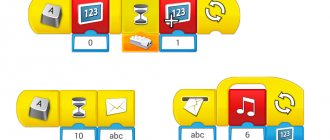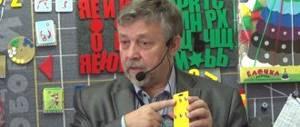10/30/2016 Dinara Gagarina
How and why is robotics being introduced into preschool education? What kind of robots do 5-6 year old children make? What techniques and designers should you use? And how this happens in kindergarten, where robotics has become one of the central topics of the educational and educational process.
Have you already implemented robotics in your kindergarten? So far, only a child has been introduced into the kindergarten! (from Facebook)
Why is robotics needed in kindergarten?
The reasons for the increasingly active entry of robotics into preschool education are related to its capabilities (teachers would say “didactic capabilities”) and the tasks solved with its help:
- development of fine motor skills by working with small parts of construction sets;
- mathematics and counting skills: even at the level of selecting parts for a robot, you have to deal with beams of different lengths, comparing parts by size and counting within 10-15;
- first programming experience;
- design skills, familiarity with the basics of mechanics and propaedeutics of engineering education;
- team work: the robot is usually made by two or three people;
- presentation skills: when a project is completed, you need to talk about it.
Each of these tasks in itself is not unique, and you can easily find a dozen more activities that solve it, but robotics amazingly combines them all. And all this is done:
- in a playful way;
- with child-friendly educational materials (Lego or similar).
Robotics lesson in LegoPolis kindergarten
Preschool robotics – what is it?
Robotics in kindergarten is a creative activity during which the child learns to think independently and in a team, studies the operation of mechanisms, and tries to create his own robots. Don’t think that everything is so tricky and complicated that only some 5-year-old children are able to cope with the tasks. Classes are organized in such a way that every child understands the functioning of various simplified mechanisms. Not all adults are able to believe that at this age children can learn not only to assemble models, but also to create a simple program for them on a computer.
All robotics can be divided into three main types:
- Sports. Within the framework of such robotics, a competitive component of training is practiced. Everyone must demonstrate what level they have reached.
- Creative. Does not involve competition. The creation of robots itself is the main goal.
- Educational. Combines the basics of physics, computer science, mathematics, and technology. Aimed at the comprehensive development of the child.
In preschool robotics, the emphasis is on a creative and educational way of presenting and learning material.
In robotics classes, children design all kinds of machines that surround them in everyday life, fairy-tale characters, animals, various objects and much more that interests them at that age.
Is everything so wonderful?
You may ask why robotics has not been used before if it is so useful and unique? Again, there are several reasons.
Firstly, education is the most conservative of all areas and any changes here are very slow. Secondly, today there are more opportunities both in terms of choosing and purchasing designers, and in terms of methods, and in terms of personnel training. Emerging requests from parents also play a certain role in this process. Another factor - let's call it the last one on the list - in some regions there is “pressure” from above, when education authorities recommend kindergartens to introduce robotics classes.
Formally, the presence of robotic constructors in the educational environment of Perm preschool educational institutions is a requirement of the Perm Department of Education. So, at different levels, it is present in all the gardens of Perm. The only question is the volume of implementation -
says Pavel Krendel , director of the Perm Center for Robotics Development. “Implementation volumes” in practice sometimes mean purchasing equipment and storing it in the farthest room. Because “it will be more intact, but there is still no one to work.”
In general, the process is difficult and slow, the situation in the regions is very different. Where such classes are introduced, it is often a paid service. In the regions, the cost of one lesson is 150-300 rubles.
Here is how Antonina Tsitsulina , president of the Association of Children's Goods Industry Enterprises, comments on the industry:
At the congress of preschool education, more than half of the participants were sincerely amazed to see a course on robotics for preschoolers by Pavel Frolov (head of ROBBO and Scratchduino - editor's note). And they grieved - who can teach?
However, training is active. I sometimes work on robotics courses for teachers; representatives of preschool education come to them more and more often.
Over two years, teachers from more than twenty kindergartens attended courses on working with the Lego WeDo constructor, -
says Andrey Koryagin , a representative of the Pifagrad center (Voronezh), which organizes such courses.
STEM technologies in preschool education
STEM technologies in preschool education are being introduced gradually in a specially organized environment. First, children are involved in construction. When its principles are mastered, specialized Lego sets are used with the ability to model more complex objects. The tools also include interactive toys that encourage children to learn new scientific and mathematical principles and think outside the box.
STEM technologies in preschool education make it possible in the future to solve the main problem associated with providing enterprises with high-level professionals. In the future, new professions related to high technologies, located at the intersection of different scientific fields, may appear.
STEM technologies and robotics
Robotics is directly related to STEM education. It is not a separate discipline, but part of an integrated approach. Children begin classes with an understanding of engineering and programming. In robotics classes in preschool education, various mechanisms, basic electrical engineering and programming languages necessary for the correct operation of robots are studied.
So, if you want your child to learn about modern technology from an early age, do well in school, and be able to do what they love in the future, send them to a center that specializes in STEM technologies. Robotics in preschool education is available to children aged four years and older.
Tatyana and LegoPolis
Meet Tatyana Duboenko . A year and a half ago, she came to work as the manager of an ordinary municipal kindergarten No. 28 on the outskirts of Perm.
Tatyana Duboenko, head of the LegoPolis kindergarten
At the same time, Tatyana and I met on Facebook, then we met at Robofest in Perm. She studied competitive projects and carefully watched defenses in Jr FLL. Her guys did not submit their projects to the competition then. Then everything developed rapidly. Sadik introduced robotics programs and became a resource platform for the regional IKaRenka. In October, the boring kindergarten number turned into the non-boring name LegoPolis. Tatyana shattered my idea of kindergarten directors. And about kindergartens too. This municipal kindergarten has not only turned itself into a dream garden, but is also actively involved in charitable activities - Tatyana herself and several teachers have been conducting classes in light construction at the children's oncology center for six months.
Robotics (not only Lego, more on that below) and light engineering have become central to the educational process of kindergarten. Robotics is included in the program of the senior and preparatory groups. In the preparatory group, basic classes are held free of charge and are mandatory for everyone once a month. For those wishing to study robotics on a larger scale, there are additional paid classes. Construction-related activities are actively taking place for younger children. Lego is used very actively on them:
Such classes, among other things, also become a kind of preparation for the next stage.
There are many construction sets and other manufacturers in the kindergarten.
Robots in kindergarten? Isn't there something artificial and conditioned by current fashion in this?
Reading “The Ryaba Hen” to children, we see that instead of listening to the fairy tale, they begin to spread the pages of the book with their fingers, trying to enlarge the picture, -
says Tatyana. Fashion or not, if you take into account the interests of children, and not break them, it turns out more effective. Otherwise, you can be indignant a lot that children today are not the same.
Application of Lego construction technology and robotics in modern preschool education
Bibliographic description:
Kartina, I. E. Application of Lego construction technology and robotics in modern preschool education / I. E. Kartina, Yu. S. Lutsik, I. V. Bondar. — Text: direct // Questions of preschool pedagogy. — 2020. — No. 3 (30). - pp. 11-13. — URL: https://moluch.ru/th/1/archive/157/4887/ (access date: 10.10.2020).
In the article, the authors describe the technology of Lego construction and robotics, using the example of their experience working in a kindergarten.
Keywords: construction, children, Lego, robotics.
Child psychologists have proven that if there is no imaginative play in a child’s life, then he begins to perceive the world around him inadequately. A Lego constructor makes it possible not only to assemble a toy, but also to play with it. Using the parts of not one, but two or more Lego sets, you can assemble an almost unlimited number of variants of toys that set the plots of the game [1, p. 4].
Designing with Lego sets fully meets the interests of children, their abilities and capabilities, since it is an exclusively children's activity. Consequently, thanks to it, the child improves especially quickly in skills and abilities, in mental and aesthetic development. It is known that fine motor skills of the hands are connected with speech centers, which means that a child who is advanced in construction develops speech faster. Dexterous, precise hand movements enable him to master writing techniques faster and better.
A child is a born designer, inventor and researcher. These inclinations inherent in nature are especially quickly realized and improved in design, because the child has an unlimited opportunity to invent and create his own buildings and designs, while showing curiosity, intelligence, ingenuity and creativity [2, p. 3].
Modern children live in an era of active informatization, computerization and robotics. A characteristic feature of our life is the increasing pace of change. We live in a world that is completely different from the one we were born into. And the pace of change continues to accelerate.
Today's preschoolers will:
− work in professions that do not yet exist;
− use technologies that have not yet been created;
− solve problems that we can only guess about.
That is why modern preschool education must meet the goals of advanced development and modern children must study technologies that will be useful in the future, and this is robotics.
Since 2020, a “Lego kids” club has been opened in our kindergarten with the goal of mastering basic technical design skills, developing imagination and fine motor skills, eye-hand coordination, learning the concepts of “design” and its basic properties.
Rice. 1. Working with Lego “Pets”
Classes are attended by children of all age groups. Children of primary and secondary preschool age have at their disposal such types of construction sets as “Lego Duplo”, “Build Your Emotion”, “Pets”, as well as an interesting and exciting set “Fun Slides”, with which children not only build various structures , but they can also experiment by launching a ball through tunnels.
In order to develop children's design as an activity in the process of which the child develops, researchers (Z. V. Lishtvan, V. G. Nechaeva, L. A. Paramonova) proposed various forms of organizing training:
− design according to a sample;
− design based on a model;
− design according to conditions;
− design using simple drawings and visual diagrams;
− design by design;
− construction on the topic [1, p. 6].
These forms are actively used in classes on Lego construction and robotics.
One of the designers for the senior groups “Simple Mechanisms”. In the process of working with the set, children have the opportunity to understand what lifting force, balance, structural stability are, get acquainted with such details as a lever, gears, gears, and study the simplest mechanisms that surround us in everyday life.
Rice. 2. Construction according to the scheme
I would like to draw attention to the robotic innovation LegoWedo 2.0. This product allows children to independently create various robots and, using software, set parameters and conditions for testing the developed product.
Lego WeDo 2.0 is not only a means of developing memory, attention, thinking, and sensory skills of students, but also a means of achieving the goals formulated in the second generation Federal State Educational Standard as the results of mastering the basic educational program of primary general education (EEP).
There are several ways to conduct classes with the Lego WeDo 2.0 constructor. The duration of classes depends on the complexity of the models, time to discuss the result and analyze the assembled model, experimentation, etc. Children work both individually and in teams.
To begin with, the children get acquainted with the elements of the construction set and their names, examine the parts, sort them into boxes (by color, size, shape, etc.), and try to assemble simple models from these elements.
Then preschoolers get acquainted with the interface of the Lego WeDo 2.0 constructor program, and the basics of building a program for “revitalizing” assembled models are explained, and they become familiar with command icons and their purpose.
Rice. 3. Working with the Lego WeDo 2.0 constructor.
Next, children assemble the basic models of the kit. It is advisable that the children pronounce their actions when assembling models, correctly name the elements, and be able to explain the processes used to “revive” these models. And at the end of the lesson, an exhibition of the assembled models is set up.
Classes take place in an easy and relaxed atmosphere. The children remember with great interest the names of the parts and methods of attaching the construction set, create their own structures and build according to the diagram.
Lego construction makes it possible to fully realize the use of modern information and communication technologies for the development of communication skills and creative abilities of children, for solving cognitive, practical, research and communication problems, for the implementation of project activities of preschoolers.
Literature:
1. Feshina E. V. Lego construction in kindergarten. Methodological manual - M.: TC Sfera, 2018;
2. Kutsakova L. V. Design from building materials - M.: Mozaika - Sintez, 2020.
Key terms
(automatically generated)
: child, design, kindergarten, model.
Designers and price issue
The most common counterargument to the introduction of robotics in kindergartens and schools is money. It is traditionally believed that this is an expensive pleasure both in terms of equipment and salaries for qualified teachers. I immodestly ask Tatiana where the money comes from. State? Sponsors? Parents? The answer is always negative. There are no additional funds for robotic kits, but in the general budget of a kindergarten, finding money for several construction sets is not a problem, especially if you look at prices and suppliers. Let's give a few numbers. To train a group of 10 people you need 5 sets.
Lego WeDo and Lego WeDo 2.0
For example, let's take the most popular construction set for preschool age Lego WeDo . The kit will include:
- basic set First Robot Lego WeDo - 10,100 rubles;
- Lego WeDo resource set - 4,400 rubles (not necessary, but this significantly increases the number and variety of assembled models);
- laptop - from 18,000 rubles.
To work with Lego WeDo you will also need a license - individual (7,500 rubles) and network (20,600 rubles).
UPD: LEGO software and teaching materials have become free since January 2020.
In total, about 180 thousand rubles for an equipped robotics class. However, many sellers give significant discounts. According to our estimates, it is quite possible to keep within 155,000 rubles.
If you choose Lego WeDo 2.0 , then one construction set costs 14,600 rubles, the software is free (there is a promotion until the end of 2020 - UPD: LEGO software and educational materials have become free since January 2020), instead of laptops you can use cheaper tablets (from 5,000 rubles ). In total, a set of 5 sets and 5 tablets will cost from 100,000 rubles.
For robotics classes in kindergartens, a separate room is usually allocated - a computer lab. A regular closet is suitable for storing construction sets:
In LegoPolis, the schedule is designed in such a way that several hundred kindergarten students pass through one class. These same constructors are used in a paid club for everyone.
Other constructors
The third most popular for kindergarten after Lego WeDo and Lego WeDo 2.0 are Huna-MRT-Robotrek construction sets. The advantage of these Korean-Russian kits is that there is no need for laptops and computer class equipment. One set of Robotrack Baby-1 costs 19,600 rubles.
Designers from other manufacturers are significantly inferior in popularity, for example, Bibot and UMKI.
Thus, the Russian designer UMKI CAR4 Pathfinder costs 15,000 rubles.
Equipment with a set of methods and didactics for a group of 6-8 people for a kindergarten can cost from 38 to 45 thousand rubles, -
says Igor Voronin , developer of UMKI construction sets.
For most designers, detailed instructions and teaching materials are provided. They are focused on conducting classes in a playful way, through fairy tales and examples from the surrounding life.
What it is?
Robotics classes are a creative process in which a child manages to create his own product - a robot. You shouldn’t think that something complex is appearing, some kind of artificial intelligence - no, kids, in fact, work with special construction sets, creating figures and machines, using the teacher’s tips and their own imagination. The essence of the classes is to study mechanisms, simplify work with motors, levers, wheels, create models according to diagrams, or even invent your own. These types of activities are suitable for children aged 5-6 years. Older guys begin to get acquainted with programming - their task becomes more complicated: they need to not only assemble a model, but also write a simple program for it on a PC. Such developmental exercises provide an opportunity to develop children’s interest in technology and gain essential skills.
The classes themselves help develop perseverance, determination, and the ability to look for alternative ways to solve a problem, and these qualities, in turn, will greatly help both at school and in the child’s future life. That is why the issue of robotics classes in kindergartens was raised at the state level - this form of work allows you to form a creative personality, ready to fantasize and bring your ideas to life, endowed with spatial and constructive thinking.
Kinds
Robotics can be divided into 3 types:
- sports;
- educational;
- creative.
The sports variety is aimed at solving Olympiad problems and helps students who are interested in this area to demonstrate their success. It has a pronounced competitive element; over a certain period, a young roboticist creates his own product, and then takes part in competitions.
The creative variety is the design of a robot “for oneself”, without an orientation toward competition; creating a product is an end in itself.
Finally, educational robotics - the main object of our attention - is the integration of mathematics, physics, computer science, technology, which allows us to form and develop in a child the most important qualities of a harmonious creative personality. It identifies technical inclinations in preschoolers at an early stage, which makes their further improvement possible. In such classes, children will design cars, forklifts, airplanes - everything that they are familiar with in real life. In addition, it will be interesting for preschoolers to create their favorite fairy-tale characters from parts (some manufacturers of educational construction sets provide this opportunity).
Huna-MRT-Robotrek construction kits in kindergarten
When Tatyana came to kindergarten, several sets of Huna-MRT-Robotrek construction sets had already been purchased. They were lying on the shelves, not even printed (yes, this is how high statistics on the implementation of robotics are achieved). Today, one of the three branches of LegoPolis operates for them.
Robotics Robotrack in kindergarten. Teacher Oksana Kharina
All parts of the construction kits are plastic, bright (although some criticize the fuzzy colors), and there is a minimum of electronics. This is a preliminary, non-programmable stage of introduction to robotics for children 6-8 years old.
Constructor Huna-Robotrek
The kits teach the basics of construction, simple mechanisms and connections. Robots of this level are not programmed, and this is a plus for preschool children - children get quick results of their work without wasting time on developing an algorithm, writing a program, etc. At the same time, the designers include electronic elements: sensors, motors, control panels - all this allows you to study the basics of robotics.
We attended a class using these construction sets at LegoPolis. There are 6 children in the group, one set for two students. Classes with Huna-Robotrack are conducted as a short-term educational practice, with a total of 4 introductory classes. These are free elective classes.
Huna is easier, this is the first step in robotics, the robot is not programmable, the child has connected all these motors and can play right away, but in WeDo you need to build programs, algorithms, -
says Oksana Kharina , Huna robotics teacher from LegoPolis kindergarten.
The disadvantage of the Huna-MRT-Robotrek construction kits is that the models are assembled over several lessons; until you assemble them, you can’t disassemble them, i.e. It is inconvenient to use in a stream and you have to purchase a large quantity. In addition, preschoolers need some kind of result immediately. But for variety in the line we use them, -
says Tatyana Duboenko.
LEGO - design and robotics in preschool educational institutions.
LEGO - design and robotics in preschool educational institutions.
Currently, new games and entertainment have appeared in the education system of preschool children. Children easily master information and communication technologies, and it is difficult to surprise them with traditional visual means. The development of the educational process goes in many directions, affecting mainly the formation of the personal qualities of a preschooler. The result of the educational activities of preschool educational institutions today is considered not the sum of knowledge, skills and abilities, but the personal qualities acquired by the child: curiosity, activity, independence, responsibility and good manners.
We, teachers, strive to use a variety of techniques and methods, realizing that we ourselves must learn modern technologies, because our students live in a world of computers, the Internet, electronics and automation. They want to see this in educational activities, to study, use, understand. One of these modern methods is considered to be joint (preschoolers, teachers and parents) integration activity - Lego construction.
Every child is a born designer, inventor and researcher. These tasks inherent in nature are especially quickly realized and improved in constructive activities. Construction is a very interesting and exciting activity; it is closely connected with the intellectual development of a child.
This type of activity is distinguished by its novelty in the use of Lego, a construction set with which the child has the opportunity to communicate, explore and play.
The construction set helps children bring their ideas to life, build and imagine, working with passion and seeing the end result. Lego encourages both your head and your hands to work equally. Lego is always a new discovery, a new idea. A new impetus for development.
Children who are interested in design are distinguished by rich fantasy and imagination, an active desire for creative activity, a desire to experiment and invent; They have developed spatial, logical, mathematical, associative thinking, memory, and this is the basis of the child’s intellectual development.
Construction is closely related to the sensory and intellectual development of a preschooler. It is of particular importance for improving visual acuity, accuracy of color perception, tactile qualities, development of small muscles of the hands, perception of the shape and size of an object, space. Children try to establish what an object is like and how it differs from others; master the ability to measure the width, length, height of objects; begin to solve constructive problems “by eye”; develop imaginative thinking; learn to imagine objects in different spatial positions, mentally change their relative positions. In the course of classes, work is being done on the development of the intellect of imagination, fine motor skills, creative inclinations, the development of dialogic and monologue speech, and the expansion of vocabulary. Particular attention is paid to the development of logical and spatial thinking. Pupils learn to work with the proposed instructions, develop the ability to cooperate with a partner and work in a team.
How does a lesson with LEGO WeDo work?
Galina Krendel ’s Lego WeDo class at LegoPolis Galina says that Lego’s methodological developments are aimed at children from 8 years old, so for kindergarten they have to be adapted or developed independently. A laptop is required to use WeDo, so the first lesson usually involves learning how to use a computer.
The lesson begins with a discussion of the problem and possible mechanisms for solving it - in our lesson we discussed different types of loaders. Next, roles in the team are assigned and assembly begins according to the instructions on the laptop screen.
Robotics with Lego WeDo in kindergarten. Teacher Galina Krendel
After the robot is built, children begin programming. At the lesson where we were, the algorithm was spoken out by the teacher, the program was compiled by the children. Further it is planned that they will be able to come up with algorithms themselves. Galina says that all children are different, there are groups where, already at the initial stage, they can immediately move on to independent development of algorithms.
The progress and emotional background of the lesson are best seen in the video. The lesson was not open in the traditional way; we asked the kindergarten administration not to prepare anything special, but to conduct the most ordinary lesson in a “normal” mode.
Is this robotics?
Perhaps it would be more correct to call such activities simply design or the basics of mechanics and programming. But robotics is a better and more understandable word for children (and parents). It’s unlikely that anyone seriously believes that robotics for preschoolers has anything in common with the operation of industrial robots. On the other hand, such classes are the first step towards further training in robotics: familiarization with mechanics, program control, feedback and other elements.
Entertaining robotics thanks the staff of the LegoPolis kindergarten for their help in preparing the material.
Photo Entertaining robotics.







